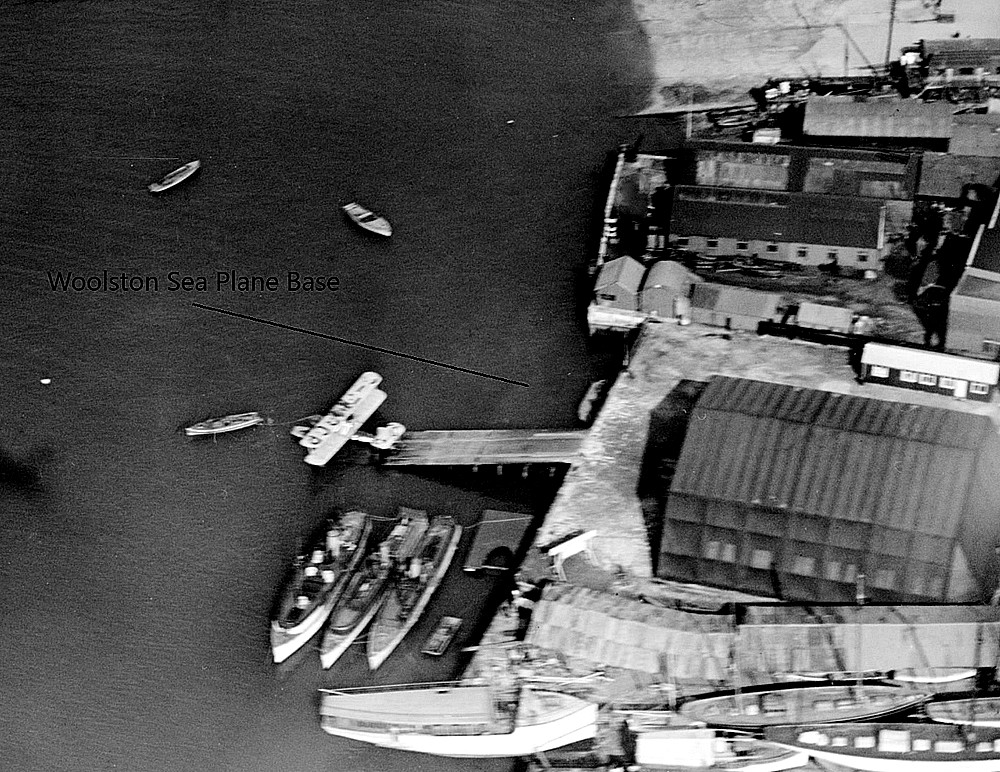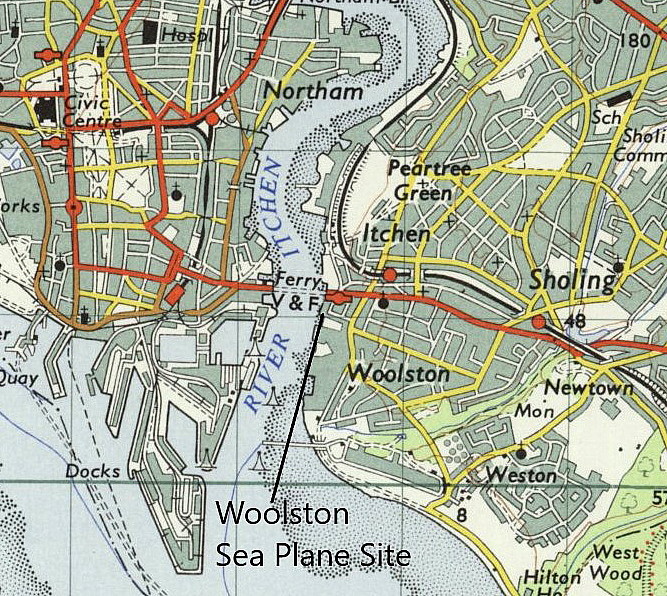Woolston
WOOLSTON: Civil seaplane and flying boat operating area and later Air Port.
IMPORTANT NOTE
This entry involves two distinctly different sites situated very close to each other. The first is the Pemberton-Billing later Supermarine factory started in 1913. The second is the MARINE AIRPORT established in around 1924. I believe I am correct in thinking that the factory was north of the Woolston ferry, and the MARINE AIRPORT was placed south of it. Please see SOUTHAMPTON MARINE AIRPORT for more information on that site.
Airline ops: Pre 1940: British Marine Air Navigation Co Ltd, Supermarine Aviation Co, and later Imperial Airways.
Note: I have found a mention of K&M (Kirsten & Mace) operating a service in this area. Did they operate from MARINE AIRPORT or ROYAL PIER? Or another site?
Manufacturing: Noel-Pemberton-Billing, Sopwith, Supermarine Aviation Works
Note: Taken flying south of Southampton in 1992, this picture by the author shows the River Itchen.
Location: On the River Itchen estuary, near the A3025 ‘Toll’ Bridge, SE of Southampton city centre and almost into Southampton Water
Period of operation: The aircraft factory was established in 1913 (some say 1912) and continued until World War Two. During WW2 Spitfire production was moved to several sites in Southampton, and elsewhere in the region, but probably the main factory was the facility in WEST BROMWICH in the WEST MIDLANDS?
It appears the MARINE AIRPORT for Imperial Airways, situated south of the Woolston ferry became operational in 1924 and continued to operate until the start of World War Two.
THE BEGINNINGS
In 2017 I came across the excellent book, British Aviation - The Pioneer Years, by Harald Penrose first published in 1967. He gives us this account: "Spurred by his record brevet taking, (My note - getting his pilot certificate), Noel Pemberton Billing decided that time was opportune to establish his own aircraft company. Because he was an ardent mariner, and had earned considerable capital through yacht brokerage and ship-board gun-running, his inclination was to build seagoing aircraft. In this he was stimulated by friendship with Linton Hope, a visionary naval architect of great theoretical and practical attainment, who discussed with him methods of hull building which were a unique departure from the Curtiss flying-boats and the Consuta-planked Bat-boat of Sopwith."
"Pemberton-Billing thereupon found headquarters at Woolston, on the shore of Southampton Water, among the yacht-building fraternity - and notified the world that his telegraphic address was 'SUPERMARINE', which he selected as the opposite of 'SUBMARINE'. Flight welcomed him by saying: 'His entrance into the aeronautical world should be helpful, as he is ever original and not afraid of backing his originality. One or two of his new ideas already have the promise of success written across them.'
A MICHAEL T HOLDER GALLERY
Note: The newspaper article was published in the Nottingham Journal on the 18th August 1919. Spot the glaring typo - "Submarine Aviation Co" - no doubt a result of being under the affluence of incohol after a boozy lunchtime?
SHIP LAUNCHED MAILPLANES
In Mike Roussel's excellent book Spitfire's Forgotten Designer I was delighted to discover that although the first liner to launch such a service was the French Ile de France in 1928 this service was soon dropped as being too expensive to operate. However; "On the other hand, NDL (Norddeutscher Lloyd) joined up with the German airline Lufthansa and installed catapults on their two now liners Bremen and Europa. A Heinkel He 12 was on board the Bremen for her maiden voyage in 1929, and was launched from the ship when approximately 250 miles from New York to deliver the mail a matter of hours later. On the return journey, the seaplane would be dispatched when in the English Channel to fly on to Bremerhaven. The aircraft were changed to the Ju 46 in 1932 on both the Bremen and Europa, but although New York remained as the westbound destination port for the seaplanes, the eastbound destination port was changed from Bremerhaven to Southampton. The would deliver any mail for Britain and then refuel to fly on to Bremerhaven."
LANDING ON THE RIVER ITCHEN
"Following the Zeppelin flights over Southampton, concern was growing about the German seaplanes that had been flying into Southampton with the mail for some time, landing on the River Itchen. These seaplanes were piloted by German Lufthansa pilots that had been catapulted from the ocean liners Bremen and Europa off the coast of Ireland. What was even more worrying was that their Southampton office was at the base of the Supermarine office block where there were a couple of Germans working in the mail office. It does not take too much imagination to realise that with the Spitfires being built close by, they would have been able to see what was happening, and also that the Lufthansa pilots flying seaplanes in with the mail were gaining knowledge about the port of Southampton and the Supermarine works as well as other industries in the area.
NOTES: THE SUPERMARINE AIRCRAFT FACTORY
Earlier in my research I made this note: "I’ve learnt on good authority that Supermarine had slipways here from 1913, as did Sopwith, and the Supermarine site later absorbed the Sopwith site in 1916". In 2017 I had serious reason to doubt that this was correct. I now think that the Sopwith concern was based in Cowes on the Isle of Wight. Any advice will be most welcome.
Then, in 2015 I came across the book by Mike Roussel - Spitfire's Forgotten Designer - and he tells us the results of a £500 wager with Frederick Handley Page concernng his getting his certificate to fly in one day - see BROOKLANDS (SURREY) : "The wager of £500 came in useful, allowing Billing to purchase a disused coal wharf alongside the Woolston ferry on the River Itchen in Southampton as a site to design and manufacture marine aircraft." He then says: "Interestingly the telegraphic address chosen was 'Supermarine'."
"The first Pemberton-Billing Ltd aircraft was the biplane P.B.1. It was a flying boat and was exhibited at the Olympia Air Show in March 1914." It seems the Germans were very interested in this design, but WW1 got in the way.
WORLD WAR 1
Mike Roussel then tells us: "In June 1914, Pemberton-Billing was formed as a limited company with a share capital of £20,000 put up by Noel Pemberton Billing and Alfred de Broughton, who became directors of the company. The First World War began on 28 July 1914 and Pemberton-Billing built its first land plane, a single seat scout biplane just over a week later." This was the P.B.9, known as the 'seven-day bus' and was flown from NETLEY COMMON.
Noel Pemberton-Billing volunteered for the Royal Naval Volunteer Reserve and became the planner for the attack by the RNAS of the Zeppelin factory at Friedrichshafen on Lake Constance which was a huge propaganda success, and did inflict serious damage. Whilst this was going on, his company under the direction of Mr Scott-Paine went from strength to strength building aircraft under license and repairing damaged aircraft. It appears business greatly increased when the Royal Aircraft Factory a FARNBOROUGH began to use their services.
However, according to Mike Roussel, Billing sold his shares in Pemberton-Billing in 1916 to Hubert Scott-Paine who then very quickly renamed the company as Supermarine Aviation Works Ltd. It then appears that Vickers acquired an 'interest' in the company in 1923 when James Bird took the company over from Scott-Paine; Mr Bird having developed a good relationship with Vickers Head Office.
LATER DEVELOPMENTS
It appears that Supermarine dabbled in the airline business, (using ROYAL PIER?), just after WW1 using Channel Mk.1s on services to Bournemouth, the Isle of Wight and Portsmouth.
In 1922, (others say 1923), the London & South Western Railway and the Supermarine Aviation Works combined to form the British Marine Air Navigation Company and operated services to St PETER PORT in Guernsey plus Cherbourg and Le Havre in France using Supermarine Sea Eagle amphibians. Photographic evidence shows that ALDERNEY harbour was also a destination during this period. However, later information indicates that these services actually operated from ROYAL PIER - see seperate entry.
On a 1930 Ordnance Survey Aviation Map WOOLSTON was shown as having a clearly marked area designated as a Customs Alighting Area which was mainly in Southampton Water south of the main docks and operated by Imperial Airways (?). This aspect is important as it clearly shows that as this moment in time both HAMBLE and HYTHE were also shown as seaplane and flying boat bases. HYTHE was the Imperial Airways maintenance base and HAMBLE the Armstrong-Whitworth and Avro factories.
undisclosed
This comment was written on: 2015-09-17 04:04:25Thanks very interesting blog!
Reply from Dick Flute:
I am very pleased you found it of interest. Regards, Dick
We'd love to hear from you, so please scroll down to leave a comment!
Leave a comment ...
Copyright (c) UK Airfield Guide

























